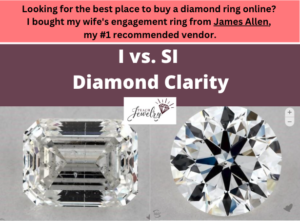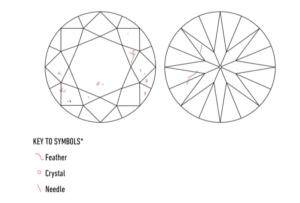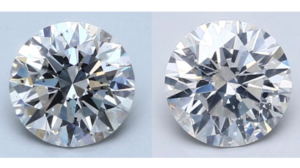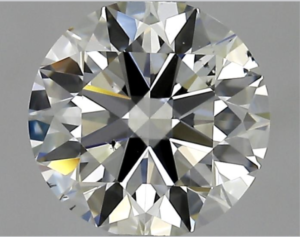
Labs that evaluate the quality of diamonds assign a clarity grade, where flawless is the highest and I3 is the lowest.
The main difference between included (I) and slightly included (SI) diamonds is inclusions in I diamonds have a more significant impact on brilliance, durability, and appearance. SI diamonds still have many blemishes, but they’re less apparent without magnification and are more fit for engagement rings than I diamonds.
Let’s examine I versus SI diamond clarity, including the specific grades within each category and how they compare in areas such as:
- Inclusions
- Prices
- Popularity
- Durability
Here are the details on each of them.
What is I Clarity Diamond?
I clarity diamonds have a significant number of inclusions that affect its appearance and light performance. The grade is a result of inclusions being easily visible with a jeweler’s loupe at 10x magnification, and they’re almost always visible to the naked eye.
Check out the high-resolution image below of an I1 diamond.
View it on the vendor’s website as well, where you can view it from every angle.
Its inclusions are immediately noticeable, and they’d be obvious even when viewed in a normal setting.
The imperfections are often ones that have more influence on the diamond’s quality. Inclusions such as pinpoints, needles, and internal graining rarely negatively affect a diamond if there are only a few small instances.
Twinning wisps, dark crystals, and cavities are more noticeable and likely to diminish brilliance. If there are several large occurrences, it’s possibly a diamond to avoid.
The latter group are the ones often found in I clarity diamonds, where the former group is more often in VVS (very, very slightly included) diamonds.
It’s a combination of issues where not only are there more inclusions present, but they’re more impactful as well.
The included category is broken into three subcategories: I1, I2, and I3.
I1
I1 is the highest grade in the included category. It’s uncommon to find an eye-clean I1 diamond, but if it’s under 0.5 carats, the inclusions may be small enough to avoid detection by the naked eye. This is why I1 diamonds are used for side stones, accents, or to line a pave band.
I2
The inclusions in an I2 clarity diamond are easily visible without magnification. They’re filled with a few large ones but also minor flaws, resulting in minimal glimmer and the potential to chip or break. The types of inclusions include clusters of dark crystals, black spots, or widespread graining, which is why they’re rarely used as the center stone in engagement rings.
I3
I3 is the lowest clarity grade a diamond can receive. The inclusions are highly visible, and it may even look like a salt and pepper diamond. If you’re at all concerned about its appearance to the naked eye and durability, avoid I3 diamonds any larger than 0.25 carats. It’s vulnerable to breaking and will have obvious inclusions to anyone viewing it.
Even though I clarity diamonds score lowest on clarity, they can be right for some situations. Save on price by using them as part of the setting and investing those savings into a higher carat or clarity for the center diamond.
What is SI Diamond Clarity?
SI diamond clarity is between VS (very slightly included) and I.
On the GIA clarity scale below, I’ve highlighted those grades.

The small inclusions are visible at 10x magnification. To the naked eye, some SI diamonds are clean while others have noticeable inclusions.
The determining factor is the size of the diamond and type of inclusions.
Check out this engagement ring, which features an SI1 diamond.
Most of the diamond appears clean, but there are marks toward the top that cause it to earn its SI1 grade. The GIA report notes features, crystals, and needles across the table and pavilion.

You can view the complete GIA report on the vendor’s website.
Other commons inclusions present in SI diamonds are:
- Knots
- Indented naturals
- Bearded girdles
- Cavities
- Etch channels
The SI category can be broken down into SI1 and S12.
SI1
In some cases, you can’t see the inclusions in an SI1 diamond without magnification. This is dependent on the size of the diamond and its inclusions, but SI1 is considered the lowest clarity grade that still passes as eye-clean. Before you buy an SI1 diamond, like the one below, examine it in-person or through high-resolution photos online.
SI2
It’s possible, though challenging, to find an SI2 diamond close to one carat without visible inclusions.
This presents the opportunity to find tremendous value because the SI2 grade significantly lowers the price. When inclusions are visible, they’ll be darker compared to SI1.
If you can’t find an eye-clean, SI2 diamond, search for one where the inclusions are near the edge so they can be covered by the setting.
Diamonds with SI clarity are used for both the center diamond in engagement rings and as accents.
To find an eye-clean diamond for my wife’s engagement ring, I landed on VS1, but you don’t always have to go that far up the scale.
What are the Differences?
1. SI Diamonds Have Fewer Inclusions
I and SI are designations of inclusions, so the primary difference between the two are the number, type, and visibility of these imperfections.
It’s worth noting that clarity grades aren’t referring to a specific number of inclusions (it’s about impact), but in many cases, lower clarity grades have more inclusions.
If you placed two diamonds next to each other, one an S1 and the other an I3, you’d easily distinguish them.
The inclusions in the I3 diamond would be more noticeable. It may have a feather visible through the crown, a black spot on a facet, or an indented natural that dips below the polished surface, like the one pictured here.

The SI1 diamond, on the other hand, could have visible inclusions or appear eye-clean.
They’d be smaller and in less prominent positions on the diamond compared to the included one whether or not they’re visible.
The differences are less obvious if the grades are only one apart. For example, it’s difficult to identify an S1 versus S12 diamond or an I1 versus I2.
Here’s an image of an SI1 and SI2 diamond.

It’s a challenge to know which one earned each grade because the distinctions are so subtle. In this case, the one on the left earned an SI1 clarity grade, the diamond on the left is SI2.
If it’s tough to distinguish them in high-resolution, they’ll likely appear identical to the naked eye.
Though you can find reliable grading through organizations such as the GIA or AGS, there’s some degree of subjectivity in every designation because even trained gemologists differ on whether a certain inclusion warrants one grade or the other.
2. I Diamonds are Less Expensive
When all other qualities are equal, diamonds with I clarity grades are less expensive than SI diamonds. The price of a diamond increases as its quality moves up the grading scale, so the SI grade results in a more expensive diamond.
As a general rule, you can expect a 10-15 percent jump in price for every step up the clarity scale, with premiums placed on moving from one category to the next, like VS to VVS.
The best way to compare the prices of I versus SI diamonds is to identify diamonds where other qualities are the same, except for its clarity grade.
For example, I compiled prices for dozens of diamonds from James Allen with the following qualities:
- Carat: 1.00
- Cut: Very Good
- Color: G
For included diamonds, the average price is $3,210. The range is $2,120-$4,440.

For SI diamonds, including both SI1 and SI2, the average price is $3,910. The range is $2,300-$5,570.
The average difference in price between those I and SI diamonds is 18 percent. The difference between the SI diamond with the highest price, and the I diamond with the lowest price is $3,450 — a savings of 61 percent.
These prices play out across most diamond retailers. As another example, the average price for a diamond with the following characteristics from Brilliance is $2,627:
- Carat: 1.00
- Cut: Very good
- Color: H
- Clarity: Included
The average price for a diamond with those traits, except an SI clarity, is $3,978. That’s an increase of 51 percent.

This shows the cost savings associated with lower clarity diamonds. It allows you to instead put that money toward other parts of the piece, whether the shank or additional diamonds.
3. I Diamonds Aren’t as Popular
If you’re searching the most popular diamond vendors online or in-person, you’re more likely to find SI diamonds. Filter by carat, color, and cut, and you’ll be presented with dozens or hundreds for each grade or weight.
The same cannot be said about I diamonds. In fact, many of the most popular retailers don’t sell diamonds for engagement rings below I1. Some avoid selling included diamonds at all.
For example, James Allen sells loose diamonds at each clarity grade down to I1 but doesn’t include I2 or I3 diamonds. They would sell for a low price, and many retailers want to avoid selling diamonds loaded with inclusions.
Blue Nile, another leading online retailer, doesn’t sell I diamonds. Instead, the lowest clarity you can buy is SI2.
Brian Gavin is the same, where its inventory stops at SI2.

As a prospective buyer, you want the maximum amount of options so you can prioritize qualities that are most important to you. Choosing a SI versus I diamond gives you these choices.
4. SI Diamonds are More Durable
Durability is an important consideration because a chipped diamond is difficult to repair and lacks value.
The most common reason a diamond experiences a break or fracture is when it suffers a drop or hard impact in a vulnerable area created by an inclusion.
These issues are more often found in I diamonds compared to SI clarity.
Not all inclusions cause the same degree of susceptibility. For example, pinpoints aren’t likely to cause durability issues. The same is true of small needles scattered across the table.
An I diamond may have a feather or cavity in a positions that’s already weak, such as an extremely thin girdle.
To determine whether there’s cause for concern, check out the GIA report. For example, here’s the report for this I diamond.

I’ve highlighted the presence of a feather and natural. The natural is located on the pavilion side near the girdle, and the feather is toward the middle of the table.
I wouldn’t worry about the durability of this I diamond because of the type of position of its inclusions.
Follow the same process for SI diamonds even though there’s less of a chance it’s prone to chipping.
Are There Similarities Between I and SI Clarity?
Affects on Brilliance
The first similarity is the inclusions affect their brilliance. The most impactful trait of a diamond in regard to brilliance is its cut, but blemishes do prevent light from entering and exiting at the right angles.
You can expect diminished brilliance as a result of inclusions for both I and SI diamonds, though it will be more pronounced at the lower end of included ones.
Visible Inclusions
The other commonality is the visible inclusions. Clarity grades above SI are almost always eye-clean, but many SI diamonds aren’t. It’s a rare instance in which included diamonds have no visible inclusions.
To illustrate, the SI1 diamond below has noticeable clarity characteristics.
The best way to learn whether a diamond is eye-clean is to view it in person or through high-quality images online. I don’t recommend buying a diamond in the I or SI range solely based on the report because it doesn’t note how visible the inclusions are when viewed in a normal setting.
Two diamonds could have similar GIA reports but look different in person.
Accents
If you’re searching for pavé, halo, or channel settings, you’ll commonly see I or SI clarity diamonds used as the accents that make up these settings.
Because the diamonds are so small, they don’t need to have as high of clarity grades to appear eye-clean.
Here’s an example of a halo and pavé setting with SI1 clarity diamonds.

The accents and center diamond appear eye clean.
This works in your favor because it reduces the price of the piece. You avoid the premiums of high clarity grades, but the visible appearance is the same as if they were flawless.
Is an I or SI Diamond Right For You?

If you’re searching for an engagement ring’s center diamond, avoid I clarity grades. The center diamond is the most prominent part of the ring. You don’t want visible inclusions.
Instead, opt for one graded SI1 or above. If it’s an SI1, view it in-person under strong lighting or in a quality photo online. There are many that are eye-clean, but you won’t know for sure based on its grade.
If you’re looking for diamonds to complement the main one as accents or pave, I diamonds are sufficient.
They’re often too small to see any of the inclusions, and their lack of brilliance won’t cause the piece to appear dull. But it’s best if you can view the piece in person first to confirm.
By exploring all the options available with I and SI diamonds, you can find the one that’s the right fit for you.

Jacob Clarke
Jacob Clarke is the founder of TeachJewelry.com.
He earned an Applied Jewelry Professional Diploma from the Gemological Institute of America (GIA) and now brings you essential information about diamonds, settings, and more.
Jacob has consulted with leading jewelry brands, and his work has been cited in Clean Origin, Diamond Nexus and industry publications.
He's also a member of the International Gem Society.
He enjoys discussing jewelry with readers, so contact him with any questions at jacob.clarke@teachjewelry.com.

















